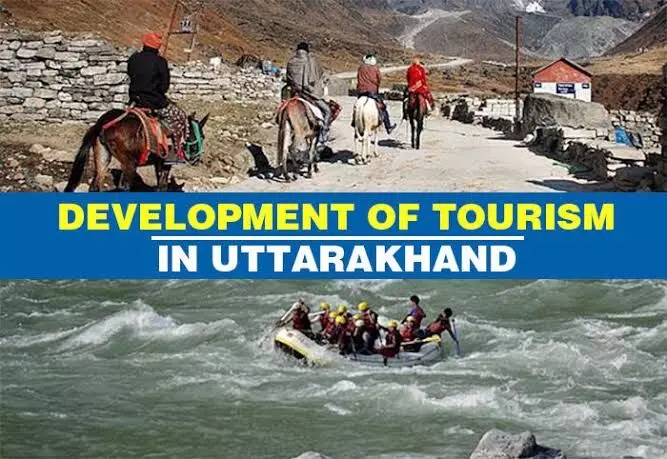Tourism vs. Water: Uttarakhand’s Fragile Balancing Act in the Hills

Uttarakhand's ambitious push to transform itself into a hub for religious and eco-tourism, spearheaded by Chief Minister Pushkar Singh Dhami, is increasingly at odds with the state's deepening water crisis. While the government promotes spiritual circuits like Jageshwar Dham, Chitai Golu Devta Temple, and Dol Ashram to boost local employment and revenue, the foundational resource—water—is rapidly vanishing from the Himalayan landscape. This contradiction exposes a critical flaw in the state's development model: economic aspirations are being built atop an ecological emergency.
Recent reports indicate that nearly 12,000 natural springs across Uttarakhand have dried up, with Almora district alone losing 83% of its springs. Given that 90% of the state's drinking water comes from these sources, the implications are dire. In districts like Pithoragarh, Champawat, and Almora, residents have been protesting for over two weeks, demanding immediate action to address the water scarcity that has left entire communities parched. In Champawat, the district hospital, serving over 300,000 people, often lacks the 67,500 liters of water it needs daily, leading to postponed surgeries and women giving birth en route to medical facilities due to water shortages.
The surge in tourism exacerbates this crisis. In 2024, Uttarakhand witnessed an unprecedented influx of visitors, drawn by its spiritual sites and cooler climate. However, this boom has strained the already limited water resources. Tourists consume approximately 40 to 70 liters of water per day, and in towns like Mussoorie, the demand during peak season doubles the available supply. In Nainital, authorities have had to increase water extraction from the lake to meet the heightened demand, risking long-term ecological damage.
Infrastructure development to support tourism further disrupts the delicate ecological balance. Construction of roads, hotels, and other facilities often involves deforestation and blasting through hillsides, which hampers groundwater recharge and destabilizes the terrain. The tragedy of Joshimath, where land subsidence forced over 700 families to evacuate, serves as a stark warning. Despite this, similar projects continue unabated, threatening other regions with the same fate.
The burden of water scarcity falls disproportionately on women, who are traditionally responsible for collecting water. With sources drying up, they must travel longer distances, often on treacherous terrain, to fetch water for their families. This not only affects their health and well-being but also limits their opportunities for education and employment. In villages like Kasar and Mukteshwar, women report spending hours each day collecting water, a task made more arduous by the increased demand from tourist accommodations.
The state's response has been inadequate. While initiatives like the Deendayal Upadhyay Homestay Scheme aim to empower locals economically, they do little to address the underlying environmental issues. Moreover, the lack of effective water management policies and the failure to implement rainwater harvesting or protect natural aquifers exacerbate the problem. Experts emphasize that without sustainable practices, the state's water crisis will only worsen, undermining both the well-being of its residents and the viability of its tourism industry.
The fundamental issue lies in policy disconnect. Local governance bodies, especially in rural and hilly areas, are poorly equipped and lack autonomy in resource planning. There is little coordination between the tourism department and the Jal Nigam or environmental boards, resulting in piecemeal interventions that often come too late. For instance, while pipelines are being laid to bring water from distant sources, the leakage and inefficiency in the system result in more than 40% water loss before it reaches the end users.
Furthermore, climate change is accelerating the crisis. Rainfall patterns have shifted dramatically, with monsoon rains becoming more erratic and cloudbursts more frequent. According to a report by the Centre for Ecology Development and Research (CEDAR), the recharge rate of aquifers has dropped significantly in the last decade, and glacier-fed rivers are also under stress due to warming temperatures. Without integrating climate-resilient water strategies into tourism planning, the state risks building castles on sand.
There is still a path forward. Experts recommend reviving traditional water harvesting systems like ‘naulas’ and ‘dhara’ (community springs), which once sustained hill communities for centuries. Investment in greywater recycling, micro-irrigation, and contour trenching can also help reduce dependence on external water sources. Tourism policies need to be realigned with ecological limits—setting carrying capacity thresholds for religious destinations, incentivizing green buildings, and educating visitors about local water realities.
Uttarakhand’s vision of becoming a spiritual tourism capital of India must be reoriented to acknowledge the ecological limitations of its geography. Water is not a limitless resource, and treating it as such in the name of development is a perilous gamble. Only a holistic, integrated approach—one that aligns environmental sustainability with economic planning—can safeguard the state’s future. Without that, the promises of jobs and growth will ring hollow against the echo of empty springs and the cries of the communities left behind.
